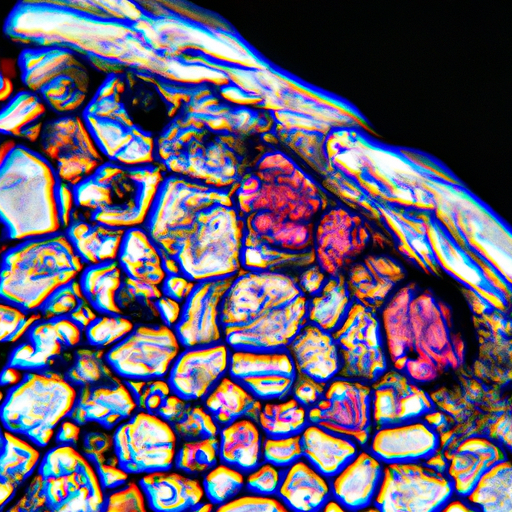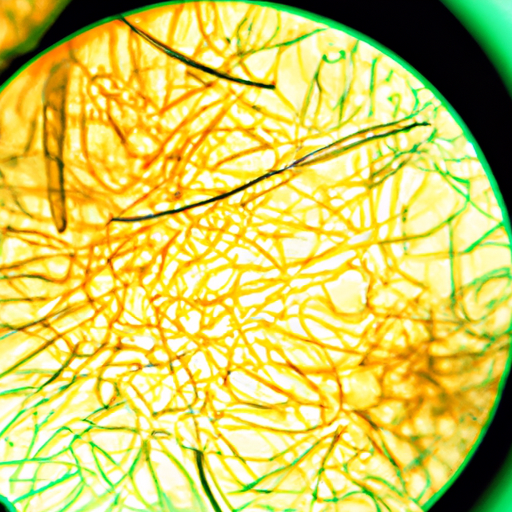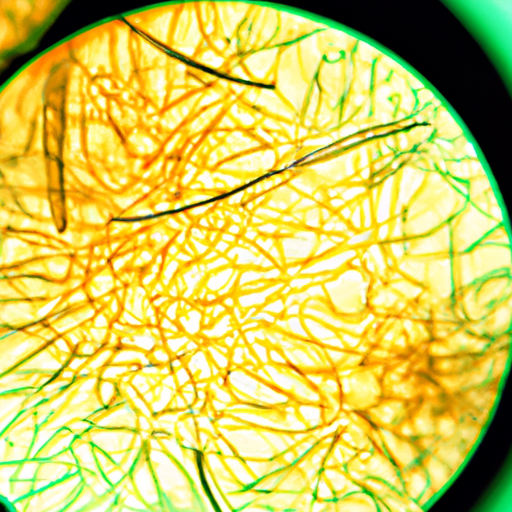Have you ever wondered if you can use your iPhone to explore the microscopic world? Well, the answer is a resounding yes! With the advancements in technology, you can now transform your beloved iPhone into a powerful microscope. This innovative concept allows you to observe and capture intricate details of tiny objects, opening up a whole new world of exploration and discovery. Say goodbye to the hassle of carrying around bulky microscopes and get ready to uncover the hidden beauty of the microscopic world, all with the convenience of your iPhone.

The Advantages of Using Your iPhone as a Microscope
Portable and Convenient
One of the biggest advantages of using your iPhone as a microscope is its portability and convenience. With just a small device that fits in your pocket, you can transform your iPhone into a powerful tool for microscopy. This means that you can take it with you wherever you go, whether you’re in the field, in the lab, or even in your own backyard. Gone are the days of having to carry around a bulky microscope – now, all you need is your iPhone.
Cost-Effective
Using your iPhone as a microscope is also a cost-effective option compared to traditional microscopes. Traditional microscopes can be quite expensive, especially if you need high magnification or specialized features. On the other hand, you likely already own an iPhone, so there’s no need to invest in additional equipment. With the right accessories and apps, you can achieve similar results at a fraction of the cost.
User-Friendly Interface
Your iPhone’s user-friendly interface makes it incredibly easy to use as a microscope. The intuitive touch screen and familiar iOS interface allow for seamless navigation and control. There are also numerous microscopy apps available that provide a simple and straightforward user experience, allowing you to capture images, adjust settings, and explore the microscopic world with ease.
High-Quality Image Capture
One of the impressive features of using your iPhone as a microscope is its ability to capture high-quality images. iPhones are equipped with advanced cameras that can produce sharp and detailed images. When combined with the right lens attachments and lighting accessories, you can achieve excellent image quality that rivals that of traditional microscopes. This is particularly beneficial in scientific research and medical applications where accurate and clear imaging is crucial.
Versatile Applications
Your iPhone’s versatility extends beyond its use as a microscope. By leveraging its capabilities and pairing it with different accessories and apps, you can explore various fields and applications of microscopy. From observing cells and tissues to examining microorganisms, the possibilities are endless. Additionally, your iPhone’s portability and convenience allow for easy transition between different applications, making it a versatile tool for both professional and recreational use.
Accessories for iPhone Microscopy
Clip-On Lens
To enhance the magnification capabilities of your iPhone as a microscope, clip-on lenses are a must-have accessory. These lenses easily attach to your iPhone’s camera and offer different levels of magnification, allowing you to zoom in and explore the microscopic world in detail. They come in various types, such as macro lenses for observing larger specimens and micro lenses for higher magnification.
Microscope Stand
A microscope stand is an essential accessory that provides stability and precision when using your iPhone as a microscope. It holds your phone securely in place, minimizing shaking and ensuring accurate focus. Some microscope stands also offer adjustable height and angle capabilities, allowing you to position your iPhone for optimal viewing and image capture.
Lighting Accessories
Proper lighting is crucial for obtaining clear and well-lit images when using your iPhone as a microscope. Lighting accessories, such as LED ring lights and light diffusers, can help you achieve the ideal lighting conditions for your microscopy needs. They provide consistent and uniform illumination, reducing shadows and enhancing the visibility of your subjects.
Slides and Coverslips
Slides and coverslips are essential for preparing and mounting specimens when using your iPhone as a microscope. Slides provide a flat surface on which you can place your specimens, while coverslips help protect the specimens and prevent them from being damaged. These accessories ensure that your specimens are properly positioned and held securely in place, enabling you to obtain clear and focused images.
Methods for Converting Your iPhone into a Microscope
The DIY Approach
If you’re feeling creative, you can take the do-it-yourself (DIY) approach to convert your iPhone into a microscope. There are numerous tutorials and guides available online that provide step-by-step instructions on creating homemade microscope attachments using readily available materials. While this method may require some ingenuity, it allows for customization and can be a cost-effective option.
Commercial Lens Attachments
Alternatively, you can opt for commercial lens attachments specifically designed for iPhone microscopy. These attachments are readily available and offer a range of magnification options. They are usually easy to attach and detach, making them convenient for on-the-go microscopy. Commercial lens attachments are designed to provide optimal optics and image quality, offering a reliable and user-friendly solution.
Using a Compound Microscope
If you already own a compound microscope, you can utilize your iPhone in conjunction with it to capture images and videos. By carefully aligning your iPhone’s camera with the microscope’s eyepiece, you can take advantage of the microscope’s magnification capabilities while utilizing your iPhone’s imaging capabilities. This method allows for high magnification and can be particularly useful when using specialized microscope objectives.
Magnification Apps
In addition to lens attachments, there are also various magnification apps available that can further enhance your iPhone’s microscopy capabilities. These apps utilize digital zooming and image processing techniques to increase magnification beyond what is possible with just the lens attachments. While the quality and effectiveness of these apps may vary, they offer an interesting option for exploring the microscopic world at higher levels of detail.

Exploring the Microscopic World with Your iPhone
Observing Cells and Tissues
Using your iPhone as a microscope opens up exciting opportunities for observing cells and tissues. Whether you’re conducting biological research, studying for a science class, or simply curious about the intricacies of the human body, your iPhone can provide a glimpse into this microscopic world. With the right lens attachments and proper techniques, you can capture images and videos of cells, tissues, and even subcellular structures.
Examining Microorganisms
Microorganisms are fascinating creatures that play essential roles in various ecosystems. With your iPhone as a microscope, you can explore the diverse world of microorganisms. From bacteria to protozoa, you can observe their structures, movements, and interactions. This can be particularly useful in research, education, or even for personal interest in microbiology and environmental studies.
Discovering the World of Minerals
The world of minerals is vast and visually stunning. With the help of your iPhone as a microscope, you can venture into this world and explore its intricate details. By examining mineral samples at high magnification, you can observe their crystal structures, surface textures, and colors. This can be valuable for geologists, mineralogists, or anyone with an interest in earth sciences and gemology.
Examining Plant and Animal Structures
Whether you’re a botanist, zoologist, or simply fascinated by the diversity of life on Earth, your iPhone can serve as a valuable tool for examining and capturing images of plant and animal structures. From the delicate petals of a flower to the intricate structure of an insect’s wing, your iPhone’s microscopy capabilities allow for detailed observations of the natural world. This can be beneficial for scientific research, education, or simply satisfying your curiosity about the wonders of nature.
Challenges and Limitations of iPhone Microscopy
Limited Magnification Range
One of the main limitations of using your iPhone as a microscope is its limited magnification range compared to traditional microscopes. While lens attachments and apps can provide varying levels of magnification, they may not reach the same levels as dedicated microscope objectives. Therefore, for certain applications that require extremely high magnification, a traditional microscope may still be the preferred choice.
Lighting Constraints
Another challenge of iPhone microscopy is lighting constraints. Proper illumination is crucial for obtaining clear and well-lit images. However, the built-in flash of an iPhone may not always provide sufficient lighting, especially for high magnification imaging. External lighting accessories can help to some extent, but achieving consistent and uniform illumination may still be a challenge in certain conditions.
Stability and Focus Issues
Using your iPhone as a microscope can also present stability and focus issues. Shaking hands or accidental movements can disrupt the stability of the setup, leading to blurred or distorted images. Achieving and maintaining precise focus can also be challenging, particularly at higher magnifications. Therefore, using a microscope stand or a stable surface is essential to minimize these issues and ensure accurate image capture.
Applications and Industries Benefiting from iPhone Microscopy
Medical and Healthcare
The medical and healthcare industries can greatly benefit from iPhone microscopy. In research and diagnostics, the ability to capture high-quality images of cells and tissues with your iPhone can aid in the identification and analysis of various diseases and abnormalities. It allows for convenient and efficient documentation, remote consultations, and patient education. Additionally, iPhone microscopy can be utilized in telemedicine applications, bringing healthcare access to remote or underserved areas.
Education and Research
Education and research are fields that can significantly benefit from the use of iPhones as microscopes. In educational settings, students can have hands-on experiences with microscopy without the need for expensive equipment. They can explore the microscopic world in a more interactive and engaging manner, fostering scientific curiosity and learning. In research, iPhones can serve as valuable and accessible tools for data acquisition and documentation, allowing for more efficient and portable research studies.
Industrial Quality Control
iPhone microscopy also has applications in industrial quality control. With the ability to capture detailed images and videos, it can be utilized for inspecting manufacturing processes, identifying defects, and ensuring product quality. This can be particularly useful in industries such as electronics, textiles, and automotive, where microscopic analysis is crucial for maintaining product standards.
Environmental Monitoring
Environmental monitoring is another area where iPhone microscopy can make a significant impact. From assessing water quality to studying soil composition, this portable and accessible tool can be used for various environmental analyses. It allows for on-site testing and data collection, enabling researchers and environmentalists to monitor and address potential issues in real-time.
Tips for Getting the Most Out of iPhone Microscopy
Proper Lighting Techniques
To achieve optimal imaging quality with your iPhone as a microscope, proper lighting techniques are essential. Experiment with different lighting angles and intensities to minimize shadows and enhance contrast. External lighting accessories, such as LED ring lights, can provide consistent and uniform illumination. Additionally, positioning your specimens on a light-colored background can help enhance visibility and detail.
Using Image Analysis Apps
Image analysis apps can be valuable tools for getting the most out of your iPhone microscopy. These apps allow you to analyze and measure various aspects of your images, such as cell size, color intensity, and morphology. They can aid in quantitative analysis and provide valuable data for research or diagnostic purposes. Explore different image analysis apps available and find one that suits your specific needs and preferences.
Optimizing Camera Settings
To enhance the image capture capabilities of your iPhone, optimize the camera settings for microscopy. Adjust the exposure, focus, and white balance settings to achieve the best possible image quality. Additionally, consider shooting in RAW format to preserve maximum image information for post-processing. Experiment with different settings and techniques to find the optimal configuration that suits your specific microscopy needs.
Exploring Alternative Techniques
While using your iPhone as a microscope provides a wealth of opportunities, don’t be afraid to explore other alternative techniques. Combine your iPhone with other tools, such as spectroscopy attachments or polarizers, to expand your analytical capabilities. Experiment with different sample preparation techniques or staining methods for improved visualization. The versatility of your iPhone allows for experimentation and creativity in exploring the microscopic world.
Comparing iPhone Microscopy with Traditional Microscopy
Portability and Accessibility
When it comes to portability and accessibility, iPhone microscopy wins hands down. Traditional microscopes are often large, heavy, and require a stable lab setup. In contrast, your iPhone can go with you wherever you need to go, allowing for microscopy on the go. This is particularly beneficial for fieldwork, research in remote locations, or situations where a traditional microscope is not readily available.
Image Quality and Resolution
While traditional microscopes may offer higher magnification and resolution capabilities, the image quality and resolution of iPhone microscopy have improved significantly over the years. iPhones now come equipped with advanced cameras that can capture sharp and detailed images. Combined with the right lens attachments and proper techniques, the image quality and resolution achieved with iPhone microscopy can rival that of traditional microscopes in many cases.
Cost and Affordability
In terms of cost and affordability, using your iPhone as a microscope is a more budget-friendly option. Traditional microscopes can be quite expensive, especially if you require high magnification or specialized features. On the other hand, iPhones are already a common personal device, eliminating the need for additional equipment investment. While there may be costs associated with accessories and apps, the overall cost of iPhone microscopy is significantly lower compared to traditional microscopes.
Specialized Applications
For specialized applications that require extremely high magnification or specific microscopy techniques, traditional microscopes may still be the preferred choice. Traditional microscopes offer a wide range of capabilities, such as phase contrast, fluorescence, and polarization, which may not be easily achievable with an iPhone. However, for general microscopy purposes and a wide range of applications, iPhone microscopy can offer a practical and accessible solution.
Future Developments in iPhone Microscopy
Advancements in Clip-On Lens Technology
As technology continues to advance, we can expect significant improvements in clip-on lens technology for iPhone microscopy. Lens attachments may become more versatile, offering higher magnification capabilities and improved optical performance. Manufacturers may also cater to specific microscopy applications by introducing specialized lens attachments designed for specific imaging and analysis needs.
Integration with Virtual and Augmented Reality
Virtual and augmented reality (VR/AR) technologies are rapidly evolving, and their integration with iPhone microscopy holds great potential. Imagine being able to explore the microscopic world in a virtual or augmented environment, enhancing the immersive experience and analytical capabilities. This integration could revolutionize education, research, and various industries that rely on microscopy.
Enhanced Image Analysis Algorithms
Improvements in image analysis algorithms are expected to enhance the capabilities of iPhone microscopy. These algorithms can help automate and streamline the image analysis process, enabling faster and more accurate data extraction. With advancements in artificial intelligence and machine learning, we can anticipate more sophisticated algorithms that can provide valuable insights and quantitative measurements from microscopy images.
Improved Magnification Capabilities
Future developments may also bring significant improvements in the magnification capabilities of iPhone microscopy. Advances in optics and imaging sensors could enable higher levels of magnification, pushing the boundaries of what can be achieved with your iPhone. This would open up new possibilities for detailed analysis and observation of microscopic structures.
Conclusion
Using your iPhone as a microscope offers a multitude of advantages, making it a valuable tool for exploring the microscopic world. Its portability, cost-effectiveness, user-friendly interface, high-quality image capture, and versatile applications make it an attractive option for a wide range of users, from researchers and scientists to educators and hobbyists. By utilizing the right accessories, techniques, and apps, you can unlock the potential of your iPhone and embark on exciting journeys of discovery in the microscopic realm. While it may have some limitations compared to traditional microscopes, iPhone microscopy offers unique opportunities and paves the way for further advancements in the field. As technology continues to progress, we can expect even more exciting developments and possibilities in the future. So grab your iPhone, equip it with the necessary accessories, and dive into the fascinating world that lies beyond what the naked eye can see. The microscopic wonders await!




